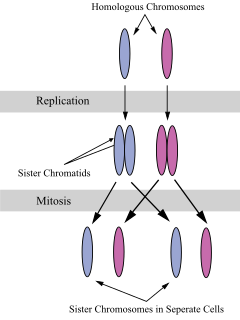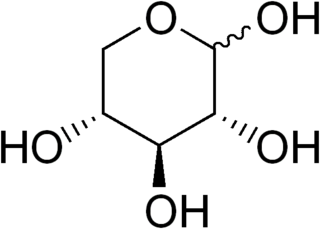Related Research Articles

Yeasts are eukaryotic, single-celled microorganisms classified as members of the fungus kingdom. The first yeast originated hundreds of millions of years ago, and at least 1,500 species are currently recognized. They are estimated to constitute 1% of all described fungal species.

Baker's yeast is the common name for the strains of yeast commonly used in baking bread and bakery products, serving as a leavening agent which causes the bread to rise by converting the fermentable sugars present in the dough into carbon dioxide and ethanol. Baker's yeast is of the species Saccharomyces cerevisiae, and is the same species as the kind commonly used in alcoholic fermentation, which is called brewer's yeast. Baker's yeast is also a single-cell microorganism found on and around the human body.

Saccharomyces cerevisiae is a species of yeast. It has been instrumental in winemaking, baking, and brewing since ancient times. It is believed to have been originally isolated from the skin of grapes. It is one of the most intensively studied eukaryotic model organisms in molecular and cell biology, much like Escherichia coli as the model bacterium. It is the microorganism behind the most common type of fermentation. S. cerevisiae cells are round to ovoid, 5–10 μm in diameter. It reproduces by budding.

Yeast artificial chromosomes (YACs) are genetically engineered chromosomes derived from the DNA of the yeast, Saccharomyces cerevisiae, which is then ligated into a bacterial plasmid. By inserting large fragments of DNA, from 100–1000 kb, the inserted sequences can be cloned and physically mapped using a process called chromosome walking. This is the process that was initially used for the Human Genome Project, however due to stability issues, YACs were abandoned for the use of Bacterial artificial chromosomes (BAC). Beginning with the initial research of the Rankin et al., Strul et al., and Hsaio et al., the inherently fragile chromosome was stabilized by discovering the necessary autonomously replicating sequence (ARS); a refined YAC utilizing this data was described in 1983 by Murray et al. The primary components of a YAC are the ARS, centromere, and telomeres from S. cerevisiae. Additionally, selectable marker genes, such as antibiotic resistance and a visible marker, are utilized to select transformed yeast cells. Without these sequences, the chromosome will not be stable during extracellular replication, and would not be distinguishable from colonies without the vector.

Totiviridae is a family of viruses. Giardia lamblia, leishmania, trichomonas vaginalis, and fungi serve as natural hosts. There are currently 28 species in this family, divided among 5 genera.

Nutritional yeast is a deactivated yeast, often a strain of Saccharomyces cerevisiae, which is sold commercially as a food product. It is sold in the form of yellow flakes, granules or powder and can be found in the bulk aisle of most natural food stores. It is popular with vegans and vegetarians and may be used as an ingredient in recipes or as a condiment.

Saccharomyces is a genus of fungi that includes many species of yeasts. Saccharomyces is from Greek σάκχαρον (sugar) and μύκης (fungus) and means sugar fungus. Many members of this genus are considered very important in food production. It is known as the brewer's yeast or baker's yeast. They are unicellular and saprotrophic fungi. One example is Saccharomyces cerevisiae, which is used in making wine, bread, beer, and for human and animal health. Other members of this genus include the wild yeast Saccharomyces paradoxus that is the closest relative to S. cerevisiae, Saccharomyces bayanus, used in making wine, and Saccharomyces cerevisiaevar boulardii, used in medicine.

Pichia pastoris is a species of methylotrophic yeast. It was found in the 1960s, with its feature of using methanol, as a source of carbon and energy. After years of study, P. pastoris was widely used in Biochemical research and Biotech industries. With strong potential for being an expression system for protein production, as well as being a model organism for genetic study, P. pastoris has become important for biological research and biotech applications. In the last decade, some reports reassigned P. pastoris to the genus Komagataella with phylogenetic analysis, by genome sequencing of P. pastoris. The species was split into K. phaffii, K. pastoris, and K. pseudopastoris.

A sister chromatid refers to the identical copies (chromatids) formed by the DNA replication of a chromosome, with both copies joined together by a common centromere. In other words, a sister chromatid may also be said to be 'one-half' of the duplicated chromosome. A pair of sister chromatids is called a dyad. A full set of sister chromatids is created during the synthesis (S) phase of interphase, when all the chromosomes in a cell are replicated. The two sister chromatids are separated from each other into two different cells during mitosis or during the second division of meiosis.
Cell Wall Protein 1 (CWP1) is a gene of Saccharomyces cerevisiae and the Saccharomyces cerevisiae-Saccharomyces bayanus hybrid, Saccharomyces pastorianus. It is closely related to the CWP2 gene and produces a small protein associated with the budding scar, known as cwp1p.
Cell wall protein 2 (CWP2) is a cell wall protein, produced by Saccharomyces cerevisiae and Saccharomyces pastorianus. It occurs throughout the cell wall and has close homology with the CWP1 gene.
Lachancea kluyveri is an ascomycetous yeast associated with fruit flies, slime fluxes, soils and foods.
Anti-Saccharomyces cerevisiae antibodies (ASCAs) are antibodies against antigens presented by the cell wall of the yeast Saccharomyces cerevisiae. These antibodies are directed against oligomannose sequences α-1,3 Man n. ASCAs and perinuclear antineutrophil cytoplasmic antibodies (pANCAs) are the two most useful and often discriminating biomarkers for colitis. ASCA tends to recognize Crohn's disease more frequently, whereas pANCA tend to recognize ulcerative colitis.

D-Xylose is a five-carbon aldose that can be catabolized or metabolized into useful products by a variety of organisms.
URA3 is a gene on chromosome V in Saccharomyces cerevisiae (yeast). Its systematic name is YEL021W. URA3 is often used in yeast research as a "marker gene", that is, a gene to label chromosomes or plasmids. URA3 encodes Orotidine 5'-phosphate decarboxylase (ODCase), which is an enzyme that catalyzes one reaction in the synthesis of pyrimidine ribonucleotides.

Pho4 is a basic helix-loop-helix (bHLH) transcription factor found in S. cerevisiae and other yeasts.

The role of yeast in winemaking is the most important element that distinguishes wine from grape juice. In the absence of oxygen, yeast converts the sugars of wine grapes into alcohol and carbon dioxide through the process of fermentation. The more sugars in the grapes, the higher the potential alcohol level of the wine if the yeast are allowed to carry out fermentation to dryness. Sometimes winemakers will stop fermentation early in order to leave some residual sugars and sweetness in the wine such as with dessert wines. This can be achieved by dropping fermentation temperatures to the point where the yeast are inactive, sterile filtering the wine to remove the yeast or fortification with brandy or neutral spirits to kill off the yeast cells. If fermentation is unintentionally stopped, such as when the yeasts become exhausted of available nutrients and the wine has not yet reached dryness, this is considered a stuck fermentation.

Jens Nielsen is CEO of BioInnovation Institute, Copenhagen, Denmark and Professor of Systems Biology at Chalmers University of Technology, Gothenburg, Sweden. He is Adjunct Professor at the Technical University of Denmark. He is the most cited researcher in the field of metabolic engineering, and he is the founding president of the International Metabolic Engineering Society. Jens Nielsen is the founder of several biotech companies.
Saccharomyces kudriavzevii, is a species of yeast in the Saccharomyces sensu stricto complex. Its type strain is NCYC 2889T. It is used in production of alcoholic beverages, including lager beers and pinot noir wine. It is isolated widely from the bark of Oak trees.

Leona D. Samson is the Uncas and Helen Whitaker Professor and American Cancer Society Research Professor of Biological Engineering at the Massachusetts Institute of Technology, where she served as the Director of the Center for Environmental Health Sciences from 2001 - 2012. Before her professorship at MIT, she held a professorship at the Harvard School of Public Health. She is on the editorial board of the journal DNA Repair. Her research interests focus on "methods for measuring DNA repair capacity (DRC) in human cells", research the National Institute of Health recognized as pioneering in her field, for which the NIH granted her the National Institutes of Health Director's Pioneer Award.
References
- ↑ Mahy, Brian W. J. (2001). A Dictionary of Virology (3rd ed.). San Diego, CA [u.a.]: Academic Press. p. 2. ISBN 978-0-12-465327-6.
- ↑ Yap, WY; Schiestl, RH (November 1995). "Nature of abortive transformation in Saccharomyces cerevisiae". Current Genetics. 28 (6): 517–20. doi:10.1007/BF00518163. PMID 8593681.
| This cell biology article is a stub. You can help Wikipedia by expanding it. |